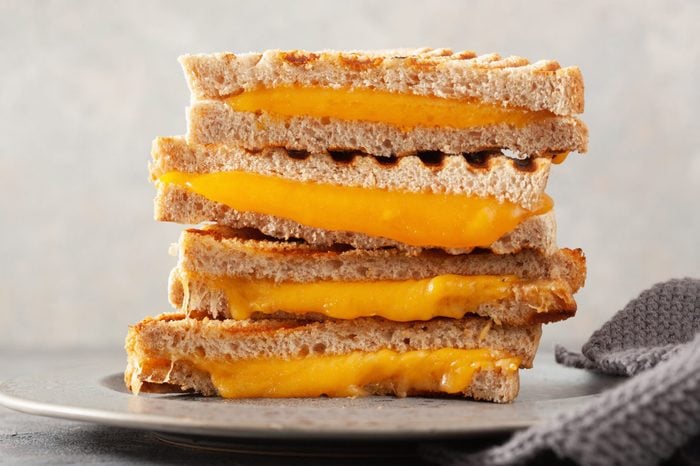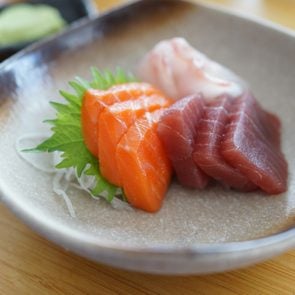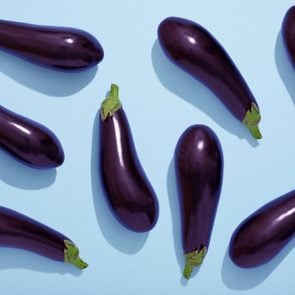What Is American Cheese, Exactly?
Updated: Mar. 21, 2022

It may be an American classic, but there’s a good chance that you don’t actually know what’s in this processed cheese.
Here’s a fun bit of food facts trivia that’s sure to amaze: Every week, more than 110 million Americans eat at least once slice of Kraft American cheese. Considering that Kraft is just one of dozens of American cheese brands on the market, it’s safe to say that we’re a country that’s crazy about cheese! Whether we’re melting slices on hamburgers, stacking them on subs, or grilling them into ooey, gooey grilled cheese sandwiches, American cheese is an American classic, just like apple pie and hot dogs. But what is American cheese, exactly? And how is it made? We’ve got the answers to some of these popular questions. When you’re up to speed, expand your cheesy knowledge by finding out what cheese curds are made of.
Is American cheese real cheese?
Technically, American cheese is not “real” cheese. From a legal perspective, the FDA requires any cheese made from a blend of two or more “real” cheeses to be labeled as “process cheese” or a “cheese product.” Most American cheese is made by blending cheddar and colby cheeses with other ingredients, like extra whey, milk proteins, vitamins, coloring, and emulsifying agents that both hold everything together and create that wonderfully gooey pull when melted. Only brands that meet these requirements (such as the most popular brand on the market, Kraft Singles) may label themselves as American cheese.
Adding to the confusion, not all cheese slices out there are legitimate American cheese. Only slices that contain more than 51 percent real cheese can be legally classified as American cheese. Anything containing less than 51 percent, like Velveeta, must be labeled as “process cheese food.” One common impostor found on supermarket shelves: “American slices,” or “sandwich slices.” This product is made by blending milk proteins, vegetable oil, and other ingredients into a substance that looks and melts like American cheese but is not, in fact, American cheese.
The FDA has very strict labeling requirements to help consumers differentiate the two, but because they look so similar, it’s easy to get them mixed up when grocery shopping. When in doubt, check the ingredients. If the first ingredient is “cheese,” you’ve got real American cheese in your shopping cart. If the first ingredient is water, milk, or oil, you don’t. This is similar to the process of figuring out what actually qualifies as butter or margarine.
How is American cheese made?
American cheese begins with two or more “real” cheeses, which are mechanically grated into fine shreds and melted together to 165 degrees Fahrenheit. The melted cheese is then blended with additional dairy products, such as milk and whey, as well as additional milk and whey proteins. Next, food coloring, flavorings, and salt are added, along with emulsifiers like potassium phosphate, sodium, or citrate, which bind the mixture and prevent it from separating when heated.
Once all the ingredients have been combined into a smooth, homogenous mixture, it can be poured into large molds to solidify into sliceable bricks, which become the American cheese slices you can buy in the deli department. Or, it could be piped through an extruding machine that creates long, thin sheets of American cheese that are cooled, sliced, and individually wrapped. Then, of course, it’s ready to be used in these American cheese recipes or melted on top of a hamburger. (By the way, here’s who invented the hamburger, in case you’re curious.)
What’s the difference between white American cheese and yellow American cheese?
The difference between white and yellow American cheese is obvious—color! While white American cheese is left au naturel, when yellow American cheese is made, coloring is added to give it a more cheddar-ish appearance. Some brands use natural colorings, like annatto or paprika. Cheaper brands may use artificial food dyes. Outside of the color, everything else about white and yellow American cheeses is exactly the same.
How is American cheese different from cheddar?
American and cheddar cheeses might look similar, but they are not the same. Cheddar is “real” cheese, made from 100 percent cow’s milk that’s been coagulated with rennet, an enzyme that separates curds from whey. The only other ingredients that may be added to cheddar cheese are salt and food coloring. Cheddar cheese is hard, crumbly, and not ideal for melting. Because it lacks emulsifiers, when cheddar cheese is melted, it will separate into cheese solids and liquified oil.
Some prepackaged cheddar slices are, in fact, cheddar, but not all. Many are actually “cheddar-flavored cheese products,” meaning they’re processed cheese slices mixed with artificial or natural flavorings to mimic the sharpness of authentic cheddar. Again, the FDA has set firm rules about what cheese is and what it can contain, so always look at the label, which will clearly state what you’re actually dealing with.
How often should you eat American cheese?
Of course, this is entirely up to you. American cheese does have some nutritional benefits: It contains high-quality protein with a low amount of carbohydrates, and since it contains real dairy, it’s naturally high in vitamins and minerals like vitamin D, vitamin A, calcium, phosphorous, and zinc. That said, American cheese is also high in calories, cholesterol, sodium, and saturated fat. One slice of American cheese contains 9 grams of fat, with 5 of those being saturated fat—about 25 percent of the FDA’s recommended daily allowance. The bottom line: American cheese can be part of a healthy diet, as long as you’re conscious of serving sizes. And as as with all cheeses, enjoy it in moderation.
Now that you know the truth about this processed food, find out the surprising ingredients in McDonald’s French fries and chicken nuggets.
Sources:
- Statista: “U.S. population: How many pounds of Kraft Singles American cheese have you used in the last 7 days?”
- FDA: “Code of Federal Regulations; Title 21”
- Serious Eats: “What is American Cheese, Anyway?”
- USDA: “Food Data Central”



